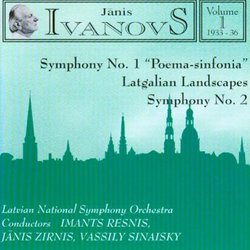| All Artists: Janis Ivanovs, Latvian Nat'l Sym Orch, Sinaisky Title: Symphony 1 Members Wishing: 0 Total Copies: 0 Label: Campion Cameo Release Date: 1/25/2000 Genre: Classical Style: Symphonies Number of Discs: 1 SwapaCD Credits: 1 UPC: 739574200829 |
Search - Janis Ivanovs, Latvian Nat'l Sym Orch, Sinaisky :: Symphony 1
CD Details |
CD ReviewsPicturesque & Impressionistic: well captured by performances David A. Hollingsworth | Washington, DC USA | 07/03/2000 (5 out of 5 stars) "The more I listen to this disc featuring the works of Janis Ivanovs (1906-1983), my admiration for this composer continues to grow. The most eminent composer of modern Latvia (which was then one of the 15 satelite nations of the former USSR), Ivanovs' earlier compositions in general were rather in the same league as Debussy, Sibelius, Franck, Rachmaninov, Scriabin, & Tchaikovsky as far as idiom was concerned. His First Symphony "Poema-Sinfonia" in B-flat Minor (1933) immediately comes to mind. The muted pizzicato and then tremolo coupled with the woodwinds entry at the mystic beginning suggest Tchaikovsky & Rachmaninov with hints of Scriabin. As the work progresses (to an andante-like tempo), it became rather pictoresque yet restrained in its' melancholic expression. Soon, a dance-like third subject closely reminiscence Gliere in his symphonic poems before the melancholy returns, giving the single-movement First Symphony a grim, serious ending. The Latgalian Landscapes (Suite for Orchestra no. 1) of 1936 is not as coherent as a suite would be in a traditional sense. However, the mood thoughout is consistent. The mystic-type Introduction is highly evocative & sets the mood of the work very effectively. It is here where the influences of Scriabin and Debussy (with a hint of Sibelius) are more of presence here. The more impressive Second Movement "The Blue Lakes" is especially Scriabineque & very close to the works of Gliere (especially the Andante movement of his Third Symphony "Ilya Murometz") while the Dvorak-like Dance (Third Movement), is attractive but rather out of place of the overall scheme of the Suite. But Ivanovs compensated this with the middle section returning back to the mysticism of the previous two movements (and incidentally, Josef Suk comes to mind in that mysticism that's rather Eastern Slavonic in tone). The Second Symphony in D Minor (1935), as most observers point out, shows the influence of Franck, Scriabin, a bit of Tchaikovsky & Rachmaninov while traces of French idiom (in the world of Franck, Chausson, & Saint-Saens) are detectable in the Finale. Ivanovs' Symphony is more personal, however. Above the influences behind the Symphony, Sibelius' are more of presence here, especially in regards to the orchestration and the brooding, nordic atmosphere (most particularly in the Andante). But, where Sibelius tends to transform ideas into fresh new ones while constantly being dynamic, Ivanovs tend to rely on culminative repetitions which to an extent robs his works (though not all) of development & an element of surprise. Nevertheless, Ivanovs' music has identity and an noticeable stamp of originality & freshness (though not in the same vein as Nielsen or Stravinsky or even Tubin) while his orchestration remain imaginative & vivid. Like Myaskovsky & Khachaturian, for instances, Ivanovs was at his best in slow movements where his sense of poetic rhetoric always manage to capture the ears, and ultimately the heart. The performances of the Latvian National Symphony Orchestra under Resnis, Zirnis, and Sinaisky were authoritative, convicted, & vivid throughout, though somewhat lacking polish. In regards to the Second Symphony, Vasily Sinaisky made a more stronger case of the work than Dmitri Yablonsky with the same Latvian National Symphony under the 1995 Marco Polo recording (which is congested in comparison to this one). Thus, this disc is a very good place to start in exploring Ivanovs' music."
|

